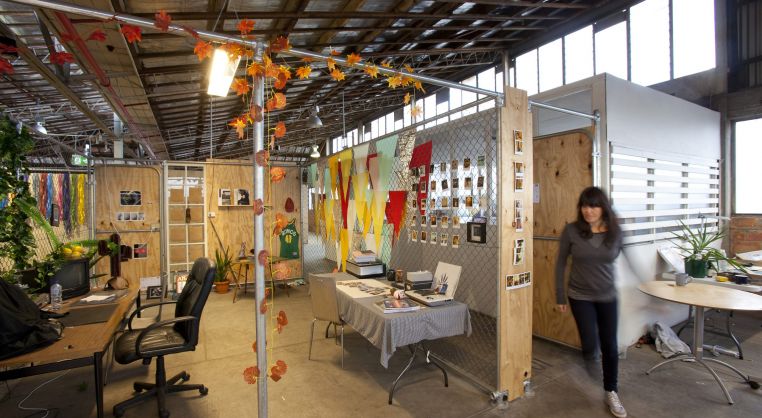River Studios provides 62 studios, housing 80 artists, in a large warehouse on the edge of the Maribyrnong River in West Melbourne. The concrete shell of the warehouse is untouched, with inexpensive, temporary divisions inserted in a manner that allows them to be easily removed at the end of the 10-year lease. Designing for growth, flexibility, reuse and disassembly were key aspects of the fit-out strategy.
River Studios is an initiative of Creative Spaces, a program of the City Of Melbourne’s Arts and Culture branch. Creative Spaces assists artists and makers to find suitable and affordable space to rent or lease though its website or by refurbishing and managing underutilised buildings. River Studios has been realised through a partnership between City of Melbourne, Arts Victoria and the owner of the building, each of which contributed $100,000 towards the building’s refurbishment.
River Studios explores a new development model for the City of Melbourne, with a building leased from the private sector to provide affordable workspaces for artists. The project was developed collaboratively with the landlord, who contributed funds to the upgrade. The small rents received for the studios cover the overall building rental, upgrades to the building over the course of the lease, and management.
Download a printable version of the River Studios case study (PDF 292 KB).
Site history and heritage
The 1930s warehouse was run down and had been vacant for twenty years when Creative Spaces signed a ten-year lease in 2011. The building is not heritage listed.
Opportunities
The architects describe the large disused warehouse as having “a real sense of excitement”. Like many industrial structures with sawtooth roofs, it has abundant natural light and ventilation on the upper two levels.
As a user group, the artists did not expect a high-quality fitout. This allowed an effective, low-budget, low-tech response, which might not have been accepted by a different user group. The site was in an Industrial Zone, which allowed artists’ studios within the current planning scheme.
Challenges
The warehouse did not meet Building Council of Australia requirements. The first building surveyor to inspect the site advised that – given the context, lease arrangement and the minimal changes proposed – there was no requirement to upgrade the entire building to current standards. Subsequent advice from the city council’s municipal building surveyor required upgrades to stairs and balustrades and plastic film to be fitted to glazing. This additional work became part of the project.
The very low budget ($300,000 for 3,000 square metres) limited the scope, but also resulted in an inventive and affordable space.
Approach and outcome
The approach was to let the existing warehouse provide the ‘architectural delight’. The building fabric was left exposed wherever possible and formed a textured, imperfect starting point for the reuse. The fitout explored strategies for growth, flexibility, reuse and design for disassembly.
The interior was originally partitioned into 57 multiuse studios of differing sizes and degrees of enclosure, along with informal gathering areas, a kitchenette, services spaces and bicycle parking. One of the larger studios was later partitioned into 5 smaller studios bringing the total to 62.
Studio partitions were made from cyclone wire fencing and timber framing. They are detailed with donated, found and salvaged items, including doors, windows, metal cladding, plywood sheets, corrugated iron and textile installations. Much of this was done in collaboration with artists and students, resulting in unusual solutions. All new work, including the disabled access lift, can be easily dismantled and reused at the end of the lease – all elements are screwed and bolted together. No wet trades were used in the project – for example, there is no concrete, no plaster, and no paint.
Lessons
- A fixed-term reuse that provides a model for the low-impact retention of industrial buildings.
- Demonstrates value gained for owners, occupants, Arts Victoria and the City of Melbourne through collaborative, relatively short-term solutions that also retain heritage for the public good.
- Inexpensive, clever fitout provides flexibility and scope for growth and can be entirely disassembled at the end of the ten-year lease.
- Collaboration between architect, students and artist-tenants led to inventive design solutions.
Project team
Architect: Breathe Architecture. Client: Creative Spaces. Building surveyor: Melbourne Certification Group. Builder: National Fencing.




